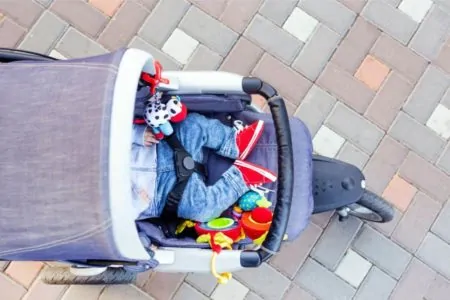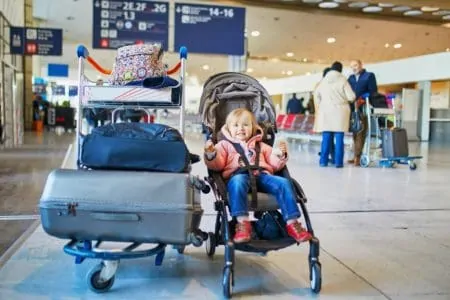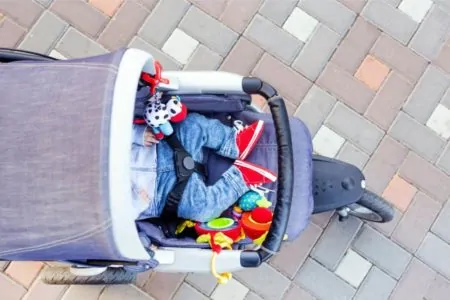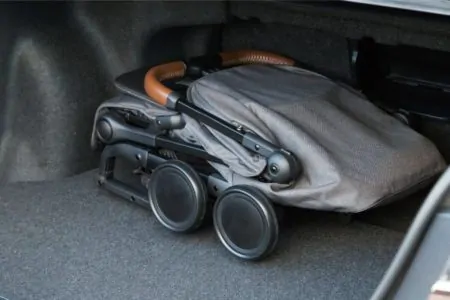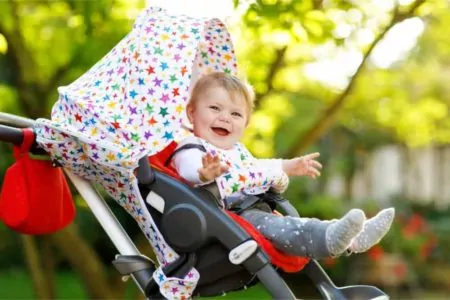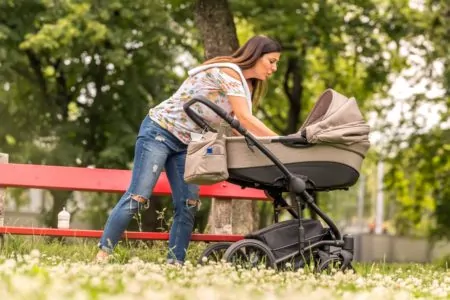Are you eager to move your baby from their car seat to the stroller? Maybe you already have a travel system and want to know when your baby can sit in a stroller.
Strollers come in various types with many different features. They are an indispensable part of our arsenal of baby gear. But knowing when you can use them is a question we should explore.
Key Takeaways
- Babies can use a stroller when they can support their own head, usually around 3 months old.
- Strollers vary in type, size, and features. Consider your lifestyle, budget, and baby’s age before buying.
- Travel systems combine a stroller and car seat, providing a versatile option from birth to toddlerhood.
- Always prioritize safety, using seatbelts, locking mechanisms, and ensuring stability when using a stroller.
When Can Babies Use a Stroller?
The suitable age for stroller use will vary from child to child. There is, however, one constant. Your baby should be able to hold up and support their own head before you consider putting your stroller into a sitting position.
Some strollers are designed to be used as a bassinet stroller from birth in a fully reclined position. Those that don’t recline fully are generally not suitable for babies below 3 months. This is about the age that your little one no longer needs your help to support their head (1).
Remember, every baby is different, and some will develop slower or faster than others. Be guided by your own judgment and that of your health care advisors as to whether your baby is ready to sit in a stroller.
Most infants that I see at the 4-month-old well-care visit have established consistent head control. In premature infants, this milestone may be delayed by a few weeks or months, depending on the birth age. Before the age of 4 months, I recommend strollers in which the infant lies flat. Once you notice your infant raising their head, doing a “belly crunch” maneuver, it is OK to use a stroller with a raised back. For more on premature infant milestones, read this article by the AAP.
Editor's Note:
Dr. Leah Alexander, MD, FAAPConsiderations When Buying a Stroller
You’ll likely use a stroller most days from the time your baby is able until they become a toddler. For this reason, choose a stroller that will adapt to your growing child and also fulfill your requirements.
Think about your lifestyle and budget, and choose one that suits these. Strollers come in different sizes, shapes, and fabrics. There are ones that are lightweight, some suitable for all terrains, some for more than one child, and many other options.
Here are some things you might want to consider before purchasing your stroller (2).
1. Your Baby’s Age
The only strollers suitable for babies younger than 3 months old are those that fully recline. Conversely, a convertible stroller will see your baby from birth through to their toddler years. These generally enable you to use a car seat on the frame as well.
Do you have more than one child? Consider a double stroller, but think about the fully reclining option within these for your newborn.
2. Your Lifestyle
Do you use a car often, prefer to walk, or use public transport? You may be athletic and spend time on the trails or jogging in the park. These factors can influence the type of stroller you choose.
Car-Friendly
If you prefer to drive places, a model that will fit in the trunk easily is a must. This could be a lightweight stroller or something a little more sturdy that folds down compactly.
Designed to be Active
For the more active parent, a sturdier stroller that has good suspension is a must to protect your baby from jostling too much. Keep an eye out for strollers that are easy to maneuver.
Jogger-style strollers are ideal for outdoor activities with your baby. However, these should not be used with little ones below about 8 months old.
Public Transport
Public transport brings additional challenges with a stroller. It’s best to look for a stroller that folds compactly. It must also be lightweight enough to carry up and down subway stairs or on and off buses. Some lightweight, foldable strollers have a strap to allow the parent to carry it like a backpack. This is useful when using public transportation.
3. Stroller Weight and Size
Consider where you will be taking and storing your stroller. Look at the dimensions when it’s folded and unfolded. You don’t want to get it home and find it won’t fit through your door or in the backseat or trunk of your car.
You also don’t want to lug a heavy stroller up the stairs to your condo or on and off the subway. Check out how heavy it is, and factor in your loved one’s weight.
4. Handle Length
Handle height is vital and needs to suit your own height. Don’t forget your partner’s height; you will be sharing the load, won’t you?
Hunching over a stroller or reaching up to push it can cause all sorts of back and shoulder issues. For this reason, choose a stroller with an adjustable handle that is high enough so you don’t have to abnormally position your body while pushing.
5. Wheels
Larger strollers or jogging strollers might have bigger wheels in a fixed position. They will also be more durable, especially on all-terrain models.
These are more than likely not necessary for navigating shops at the mall. For this, independent wheels that can be locked in position or released to swivel are a better choice. They will give you greater maneuverability for navigating all those sales racks in the baby store.
6. One or More Strollers?
Some might need more than one stroller for different situations. For example, a lightweight option for travel and a full-sized one for outings around the local neighborhood.
If you only intend to buy one stroller for your baby, choose the one that best meets your needs. Don’t buy one with features you don’t need. Yes, it’s nice to have a stroller to accommodate your baby as they grow, but it needs to suit their size now.
7. Accessories and Features
Some strollers come with added extras, while others are basic. Think about what is a must-have for you and what you can live without.
Features such as all-terrain wheels, one-handle operation, one-handed folding, food trays, cup holders, sun shades, canopies, and rain covers can be helpful. But decide what you need and see whether it comes as standard with the stroller you choose.
8. Budget
A good stroller doesn’t have to cost a fortune — but it can if you aren’t careful. You don’t have to have the “in-fashion” stroller used by all the celebrities just because of the brand name. There will be many comparable alternatives that don’t carry the high price tag.
Buy the best you can afford with all the features you need. Paying that little bit more might mean the stroller will be the only one you need and will take your little one — and possibly additional children — from baby to toddlerhood.
Main Features of Different Stroller Types
The types of strollers available and navigating through what they offer can be confusing.
Let’s take a look at the options:
1. Umbrella or Lightweight Models
Suitable for babies over 3 months old or those who can support their own heads, these are a great option for moms on the go. You can easily pop them in the trunk of your car, and they’re appropriate for traveling.
Umbrella strollers get their name from the shape of the handle, which is curved at the end like an umbrella handle. Don’t be confused and expect them to come with an umbrella or sunshade.
They generally have light aluminum frames and semi-reclining seats. This means they can fold easily, usually in one step, and tend to have swivel wheels you can lock. They can be as light as 5 pounds.
While some might fully recline, this is the exception rather than the rule. The age range for these types of strollers is usually from about 4 to 6 months to 3 years.
2. Portable or Compact Strollers
Portable strollers are in the mid-size range and are designed to be compact when folded. As a result, they often have easy-fold mechanisms. They usually have a storage basket and canopy included.
Luxury models might fully recline, have handles that extend, and have all-terrain larger wheels.
An aluminum frame is common, and the stroller tends to weigh around 15 pounds.
If the model fully reclines, then you can use it from birth and it will see you through to toddler age.
3. Full-Size Strollers
These strollers come with lots of extras. They are generally convertible and can be used with the child facing forward or backward. They have multi-position padded seats that will often fully recline and support your baby’s back and head well.
Additions like a canopy, footrest, front tray, storage basket, weather boot, good suspension, and dual-wheel brakes often come as standard.
Although there are some lighter models with aluminum frames, these strollers tend to be on the heavier side.
If they fully recline, you can use them from your child’s birth up to about 4 years old.
Many of the parents of twins and triplets I see in my practice use these types of strollers because all of the infants can fit in one stroller. While this is easier than trying to push more than one stroller simultaneously, keep in mind that they can be more cumbersome. With these types of strollers, a parent will always need to use an accessible ramp or elevator. Also, the “outward-facing” versions may have an obstructed view of the infant or toddler. It is important to ensure all straps and harnesses are secure, and that there are no choking hazards in proximity to the child.
Editor's Note:
Dr. Leah Alexander, MD, FAAP4. Travel Systems
These combine a stroller and a car seat. The infant car seat can be attached until your baby outgrows it, and then it converts to a stroller. They are generally easy to fold and compact for storage.
Some of the features you might find include a play tray, swivel wheels, brakes with a foot pedal, a reclining seat, and a storage basket.
It’s not uncommon for the infant car seat to have an ergonomic handle, base for the car, canopy, level indicator, and head cushion.
These systems will cover you from birth to about 4 years old.
5. Jogger Strollers
These strollers are usually a three-wheel design with all-terrain wheels and good suspension. However, your baby will bounce around a lot on rougher trails.
Other features are an adjustable height handle, wrist strap, hand brake, storage pouch, and weatherproof fabric.
Warning
Keeping Baby Safe in a Stroller
The Juvenile Products Manufacturers Association (JPMA) makes some suggestions regarding the safety of strollers for babies and toddlers. These include:
- Stability: Ensure your stroller has a base that is wide enough not to tip over if your little one leans over the side. Also, check that the stroller does not tip backward when the seat is reclined with your child in it.
- Seatbelts: Always ensure your baby is strapped in. Most strollers have a three- or five-point harness.
- Locking: The folding mechanism must be locked so it can’t accidentally collapse. Lock the wheels and apply the brakes when the wheels aren’t rolling.
- Little fingers: Double-check that your baby’s fingers aren’t anywhere near the stroller when unfolding and folding it.
- It’s not a shopping cart: While it’s tempting to do so, don’t hang your purse or shopping bags over the handles of your stroller. They could cause it to tip over backward. Use the storage basket, which is lower and more centered.
Nemours Hospital suggests the following stroller safety checklist.

